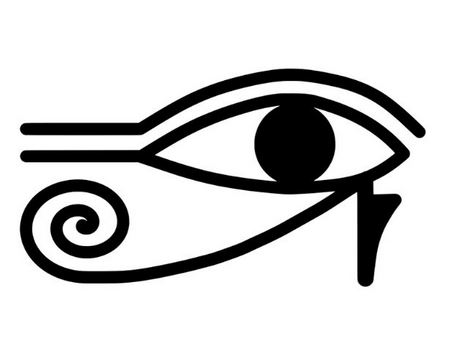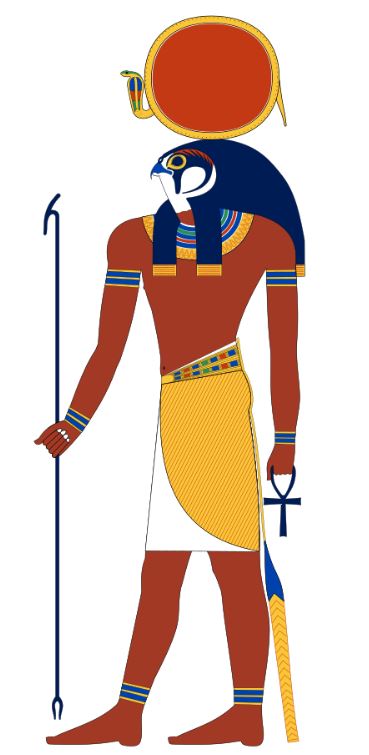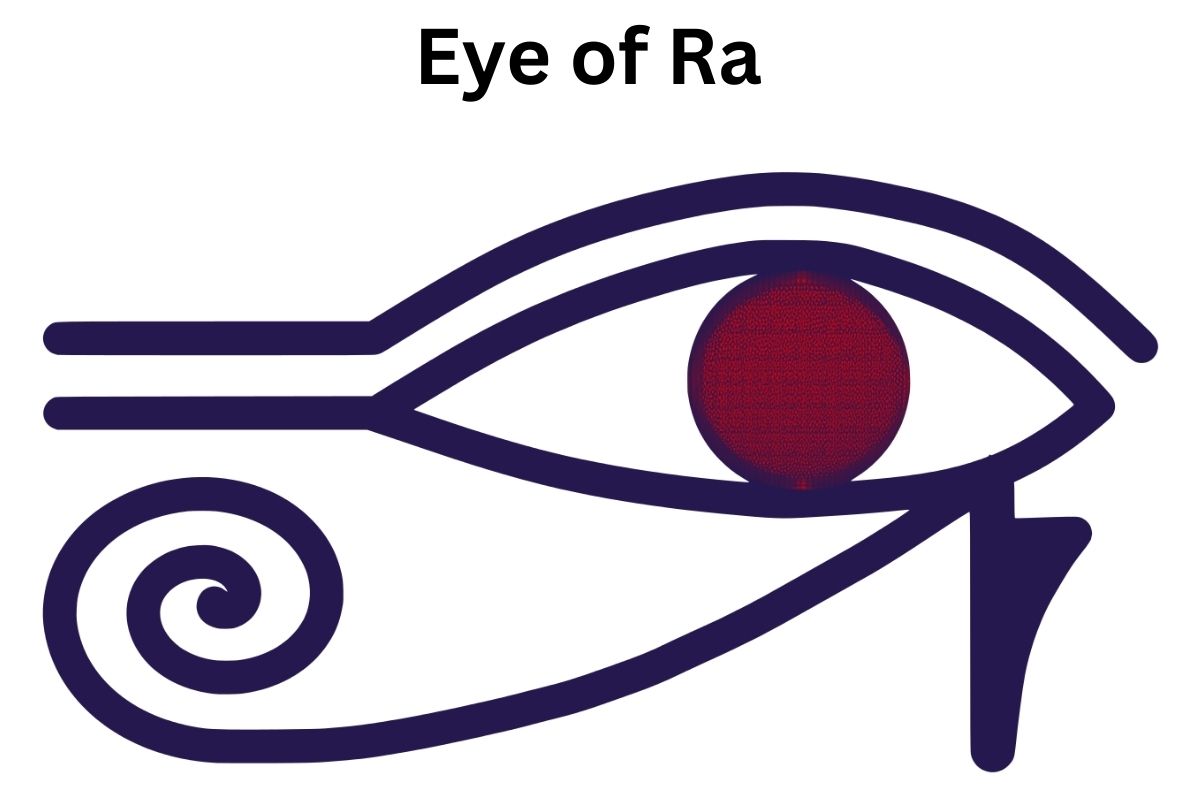The Eye of Ra is an ancient symbol that holds great significance in Egyptian mythology and culture. It is a representation of the sun god, Ra, and is often depicted as a stylized eye with various elements that carry symbolic meaning.
The Eye of Ra, also known as the “utchat” or “wedjat,” is a complex symbol that has evolved over time, with different stories and interpretations associated with it.
In this article, we will explore the origins, symbolism, mythology, and cultural importance of the Eye of Ra, as well as its legacy and continued relevance in modern times.
The Eye of Ra Symbolism and Representation
The Eye of Ra is a symbol that consists of several elements, each with its own symbolic meaning.
The most common representation of the Eye of Ra is a stylized eye, often with a curved eyebrow, elongated pupil, and teardrop or serpent underneath.

Here are some of the symbolic elements of the Eye of Ra:
- The eye itself represents Ra, the sun god. It is a symbol of his power, protection, and watchfulness.
- The eyebrow represents the horizon, where Ra rises and sets each day.
- The elongated pupil represents the sun’s rays, which are sometimes depicted as arms or hands extending from the eye.
- The teardrop or serpent beneath the eye represents the goddess Hathor, who was sometimes identified with the Eye of Ra. The serpent also symbolizes the dangerous and unpredictable nature of the eye.
- The eye is sometimes depicted with wings, which symbolize protection and divine power.
Together, these elements form a powerful symbol that represents the sun god’s all-seeing and all-knowing presence, as well as his ability to protect and watch over his worshipers.
Also Read: Facts About Ra
The Eye of Ra was a potent symbol in ancient Egyptian culture and was often used in religious and magical contexts.

Mythology
The Eye of Ra has a rich mythology associated with it, and different stories and interpretations have developed over time.
Here are some of the most well-known myths:
- The Eye of Ra is born: According to one myth, the Eye of Ra was created by the god Atum, who was the first being to emerge from the waters of chaos. Atum created the eye as a means of observing and controlling the world.
- The eye rebels: In another myth, the Eye of Ra rebels against its creator and takes on a life of its own. It becomes a wild and destructive force that Ra must tame in order to restore order to the world.
- The journey of the Eye: In this myth, the Eye of Ra leaves Egypt and travels to foreign lands, where it encounters various dangers and undergoes transformations. Eventually, it returns to Egypt, where it is restored to its proper place in the body of Ra.
- The battle with Set: In this myth, the Eye of Ra helps Ra defeat the god Set, who represents chaos and disorder. Set steals the eye from Ra, but the eye transforms into a lioness and defeats Set, restoring order to the world.
In all of these myths, the Eye of Ra is a powerful and transformative force that plays a vital role in maintaining order and balance in the world. Its journey and transformation symbolize the cyclical nature of life and the importance of overcoming challenges in order to achieve growth and renewal.
Importance in Egyptian Culture
The Eye of Ra held great importance in ancient Egyptian culture, both as a religious symbol and as a cultural icon. Here are some of the ways in which it was significant:
- Religious significance: The Eye of Ra was a key symbol in Egyptian religion, representing the power and protection of the sun god Ra. It was often depicted in temple inscriptions, amulets, and other religious artifacts, and was sometimes worshiped as a separate deity in its own right.
- Artistic significance: The Eye of Ra was a common motif in Egyptian art and architecture, appearing in everything from wall paintings to monumental statues. Its striking appearance and powerful symbolism made it an enduring icon of Egyptian culture.
- Magical significance: The Eye of Ra was also a potent symbol in Egyptian magic, where it was used in spells and rituals to invoke the sun god’s protection and power. It was often incorporated into amulets and other protective objects, and was believed to offer its wearer various forms of magical protection.
- Cultural significance: The Eye of Ra was a symbol of Egyptian identity and culture, embodying the power, wisdom, and creativity of the ancient Egyptian civilization. Its enduring legacy can still be seen today in various forms of Egyptian art, literature, and popular culture.
Overall, the Eye of Ra was a multifaceted symbol that held great significance in ancient Egyptian culture. Its enduring legacy is a testament to the enduring power and beauty of ancient Egyptian civilization.
Legacy
The legacy of the Eye of Ra extends far beyond ancient Egyptian culture, and it continues to hold relevance and fascination for people around the world today.
Here are some of the ways in which the Eye of Ra’s legacy is still felt:
- Influence on other cultures: The Eye of Ra has influenced other cultures and religions throughout history, such as the Hellenic civilization and the Greek goddess Athena, who also had a protective and watchful eye as one of her symbols.
- Pop culture references: The Eye of Ra has been featured in various popular culture references, from movies and TV shows to video games and books. Its striking appearance and powerful symbolism make it a popular choice for use in these contexts.
- Continued use in spiritual practices: The Eye of Ra is still used in spiritual practices today, particularly in modern pagan and new age communities. It is often used as a symbol of protection, power, and wisdom.
- Tourist attractions: Many of the ancient Egyptian temples and monuments that feature the Eye of Ra have become popular tourist attractions, drawing visitors from around the world to marvel at their beauty and learn about their historical significance.
Overall, the Eye of Ra’s legacy is a testament to the enduring power and fascination of ancient Egyptian culture. Its continued relevance in modern times speaks to the enduring appeal of its symbolism and mythology.
Conclusion
The Eye of Ra is a complex and powerful symbol that holds great significance in Egyptian mythology and culture. It represents the power and protection of the sun god Ra, as well as the cyclical nature of life and the importance of balance and order.
The Eye of Ra was a key symbol in Egyptian religion, art, and magic, and its enduring legacy can still be felt today in various forms of popular culture, spiritual practices, and tourism.
Its continued relevance and fascination demonstrate the enduring power and appeal of ancient Egyptian culture, and serve as a testament to the enduring legacy of this ancient civilization.
